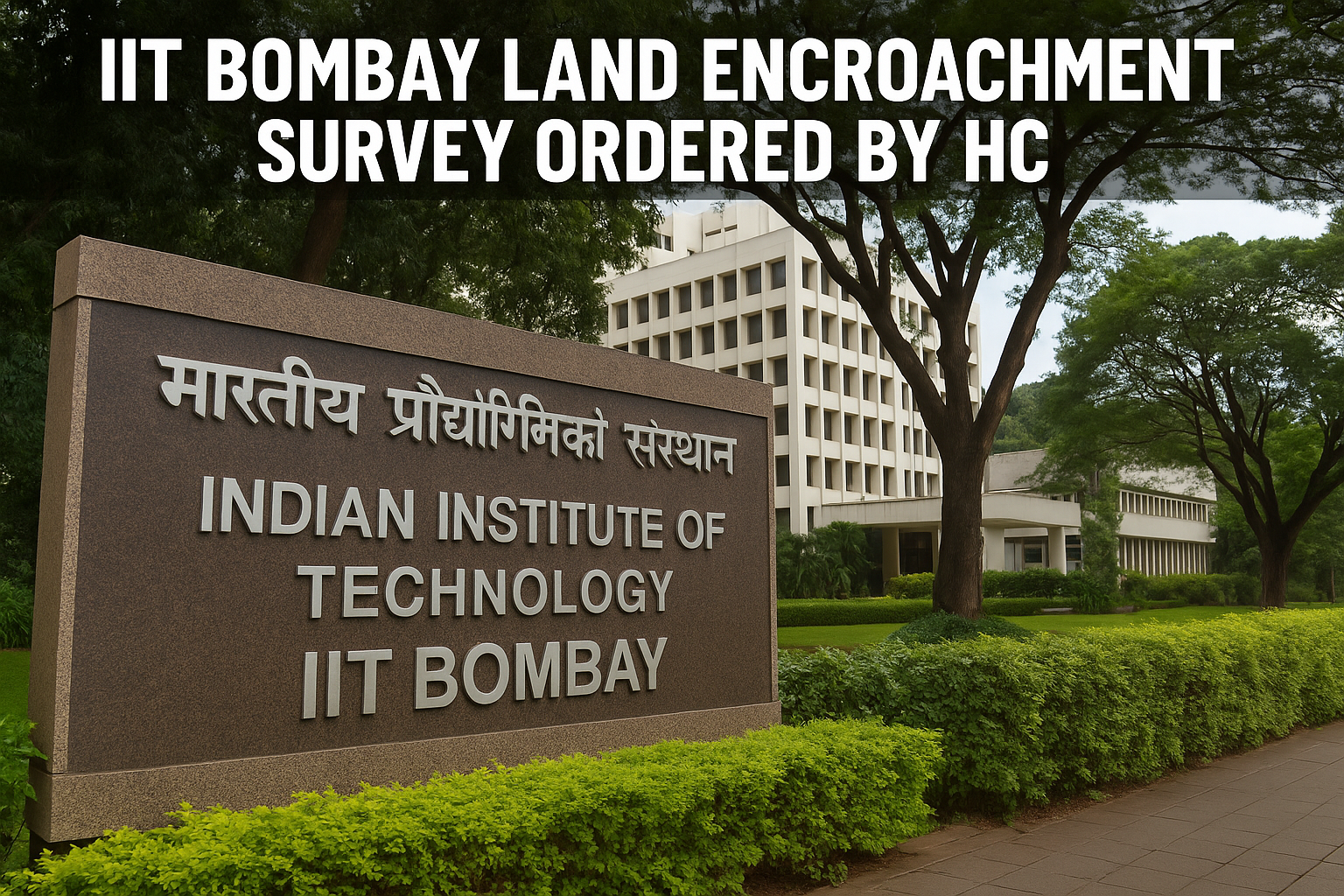Survey Ordered by Bombay High Court Over Alleged Encroachments on IIT Bombay Land
The IIT Bombay land encroachment survey has been officially ordered by the Bombay High Court, following complaints about unauthorized constructions on the institute’s property. This move comes amid rising concerns over land misuse around the prestigious campus. The survey will assess the extent of encroachments and set the stage for potential legal action.
What’s Going On with IIT Bombay’s Land?
IIT Bombay, one of India’s most prestigious educational institutions, is known not just for its academic excellence but also for its large, green campus in Powai. But recently, issues have surfaced around whether parts of this land have been taken over by unauthorized constructions or activities.
According to recent reports, there may be encroachments on government-owned land allocated to IIT Bombay. When this came to the court’s attention, the Bombay High Court didn’t waste any time and directed the city’s collector to carry out a proper land survey. The goal? To figure out who’s using the land, what it’s being used for, and whether it’s legal.
Why This Matter Is So Important
Encroachment isn’t just about illegal land use — it’s about protecting spaces meant for the public good. In this case, the affected land is meant to support education, research, and innovation through IIT Bombay’s infrastructure.
When encroachments happen, they can hurt more than just property rights. Think about it:
- Students and researchers lose valuable space they need for labs, classrooms, or even hostels.
- Environmental damage can occur if new, unregulated buildings pop up without proper planning.
- Public resources are wasted, especially when the government spends millions supporting these institutions.
The HC’s move sends a clear message: public land must be protected — especially when it’s tied to vital educational institutions like IIT Bombay.
What Did the High Court Say?
The Bombay High Court was hearing a public interest litigation (PIL) filed by Ganesh Koli, an activist who raised concerns about the alleged land grab. He claimed that the construction and occupation on some parts of IIT’s land were not only questionable but blatantly illegal.
Taking this seriously, a bench of Justices Gautam Patel and Kamal Khata asked the Suburban District Collector to carry out a full survey of the land. They want detailed findings — including site photos and area measurements — so that no ambiguity remains about who is using institutional land and how.
The Court’s Specific Orders Included:
- Identifying all encroachments that have taken place on or around IIT Bombay’s land.
- Pinpointing public facilities such as temples and shops that may have cropped up illegally.
- Submitting a report within a specific time frame with proper documentation.
So, would these findings finally help reclaim IIT Bombay’s original space? That seems to be the goal.
What Is Land Encroachment Anyway?
If you’re wondering what land encroachment really means, let’s break it down. Imagine your neighbor slowly starts building a shed or parking their car in what’s clearly your garden over several months. Before you know it, they’ve taken over your space and act like they own it.
That’s what land encroachment is — someone occupying land that doesn’t legally belong to them. It could be a corner of a backyard or in this case, sections of land meant for a national institute.
Possible Consequences if Encroachment is Proven
If the survey confirms unauthorized use of IIT Bombay’s land, here’s what could happen:
- Illegal constructions might be demolished or removed by civic authorities.
- Fines or legal consequences could follow for those responsible.
- The land could be restored to IIT Bombay for educational and institutional use.
It might sound harsh to evict or demolish someone’s shop or home. But remember—this land was never supposed to be used for commercial or private purposes. It exists to help students, researchers, and the academic community thrive.
How Common Is This Problem?
You’d be surprised. Across India, land encroachments on government property are becoming a growing concern. Whether it’s a school, hospital, or forest land, some unauthorized structures tend to creep in, and once they do, it’s hard to push them out.
Part of the reason is poor monitoring and slow administrative processes. But now, with courts stepping in proactively, we may slowly see a shift in how strictly land rights are enforced — especially for public institutions like IITs, AIIMS, or central universities.
What Happens Next?
The survey ordered by the Bombay High Court is a strong first step. Once it’s completed, authorities will have a clearer picture of:
- Which areas have been encroached upon
- What actions need to be taken
- How to protect this land in the future
We can expect more legal hearings in the coming months, possibly with action being taken to remove unauthorized structures or regularize issues if needed. One thing is clear though: IIT Bombay’s land isn’t up for grabs, and every inch counts when building the future of education.
A Matter of Protecting Public Property
Think of IIT Bombay as a lighthouse guiding India’s brightest minds. Its land isn’t just blocks of cement and greenery—it’s space for discovery, innovation, and research. Losing that space to encroachments would mean dimming that light just a little.
This case highlights something important: public land belongs to every citizen, and it should be used wisely. When big institutions like IIT Bombay are affected, we all lose out — not just students and professors but future doctors, engineers, and thinkers.
In Conclusion
The Bombay High Court’s decision to investigate the alleged encroachments on IIT Bombay’s land is more than just a legal update—it’s a wake-up call. By taking decisive action, the court has made one thing clear:
Public spaces must be protected, preserved, and respected.
Whether you’re a student, citizen, or policymaker, this case reminds us to ask the important questions: Who should use public land? And are we doing enough to keep it safe for the next generation?
Stay tuned as we follow this story in the coming weeks. The decision could set the tone for how public land across India is managed and protected in the future.
What are your thoughts? Have you seen cases like this in your city? Share them in the comments below!
For more stories like this and updates on education and civic news, bookmark our blog and stay in the loop!


